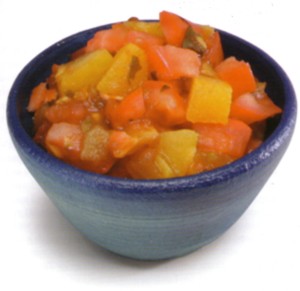 |
Recipes in this Article:
|
By Nancy Gerlach, SuperSite Food Editor Emeritus
Salsa! Just the word conjures up images of fiestas, brash rhythms, bright colors and hot and spicy flavors. But salsas are more than concoctions from south of the border. Salsas literally know no ethnic boundaries. Sambals in Indonesia, chutneys from India, the fruit and chile mixes from the West Indies, even the piccalillis of the American South all qualify as a salsa.
Salsas are used to accent meals in tropical areas of the world, and probably evolved because it’s hard to tolerate heavy cream and sauces in hot climates. Even in the tropical areas that were colonized by notorious gravy and sauce eaters, the French and English, spicy salsas are popular and gravies never took hold. And because they can replace a high fat sauce with a low fat, high flavor alternative, their popularity has continued to grow with the health conscious public.
What exactly is a salsa? One definition is that it’s a “seasoned sauce used for dipping or as a condiment.” Mexicans define a salsa as a sauce and all sauces as salsas. My own definition is that salsas are a mixture of raw or partially cooked vegetables and/or fruits, herbs, and, of course, chiles. Salsas retain their texture while a sauce is cooked and then usually pureed until smooth. Salsas have bold, strong flavors that compliment and enhance the foods with which they are served.
Just about any ingredient can be used to make salsa as long as the flavors blend well. Everything from vegetables, fruits, nuts, and even fish and meat have been turned into tasty salsas. I divide them into the following four categories, with any that don’t fit into the first three falling into a general or exotic grouping.
:The most versatile of the salsas are the ones most often associated with the term salsa. made with tomatoes, onions, and chiles, the vegetables are most often raw. Although roasting the ingredients and including some of the roasted skins, has become popular and adds another dimension to the flavor of the salsa. These salsas lend themselves well to cooking in just about any dish that calls for a tomato product, and they can also be used to top pasta or even pureed and used as a sauce. These are the ones that are found on tables throughout the Southwest and Mexico. Tomatillos, sometimes called husk tomatoes, also fall in this category.
Vegetables, other than tomatoes, can be the dominant flavor in a salsa. Popular vegetables include corn, dried beans and peas, chayote squash, artichokes, and even sweet potatoes and eggplants. There is even a wonderful salsa from Yucatan in Mexico that uses radishes as the main ingredient. These are very versatile salsas and can be warmed and served as a side dish in place of a vegetable or as a spread on sandwiches. Some of the lighter vegetable salsas can be served as a salad or used as a salad dressing.
The third category of salsas are the fruit salsas. The flavor combination of hot and sweet (and/or tart) is one of my favorites, so it follows that these salsas are also some of my favorites. Just about any fruit can be used but I personally like the tropical fruit blends that include bananas, pineapples, tamarinds, mangos and papayas. Fruit salsas are the most perishable type of salsa and are best used on the day that they’re made. Use only the freshest of fruits or, when in a pinch, substitute dried fruits. Avoid using frozen fruits as freezing tends to destroy their texture. Fruit salsas are tasty when served hot or cold, and go well with fish and poultry. They also are great with desserts. Use them as a topping for ice cream, or as a filling for a tart or pastry.
Salsas are a great accent to any meal. They add a splash of color and can compliment an entree, add zip to a chip, or, with a little creativity, become an ingredient in a delicious dish. Your imagination is the only limit to their use.
Using a commercial salsa as a base for this soup makes it quick and easy to prepare as well as allowing you to choose your spice level from mild to wild. The heat of the salsa will intensify, so I won’’t use anything that is too hot or a salsa that is habanero based. This simple soup can also be expanded to a more hearty soup, with the addition of ingredients such as cooked pinto or black beans, chicken or turkey, or even whole kernel corn. Add these to the soup after it has been pureed. For a taste of green chile, chicken enchiladas in a soup bowl, just use green chile salsa and chicken.
-
1 cup chopped onion
-
2 teaspoons chopped garlic
-
2 to 3 teaspoons vegetable oil
-
1½ cups tomato-based commercial salsa
-
3 cups chicken broth
-
2 corn tortillas, torn into pieces
-
1/4 teaspoon ground cumin
-
1/4 cup chopped, fresh cilantro
-
Salt and freshly ground black pepper to taste
-
Garnish: Sour cream
-
Chopped fresh cilantro
Heat the oil in a heavy stock or sauce pot, add the onions and saute until they are soft. Add the garlic and continue to saute for an additional minute.
Stir in the salsa, broth, tortillas, cumin, and salt and pepper. Bring to a boil, reduce the heat and simmer until the tortillas are soft. Remove from the heat and cool slightly.
Put the mixture into a blender or food processor and puree until smooth. Adjust the seasonings and stir in the cilantro.
To serve, ladle the soup into individual bowls and garnish with a dollop of sour cream and chopped cilantro.
Yield: 4 to 6 servings
Heat Scale: Mild to Hot
Noodle and Shrimp Salad with Oriental Cucumber Salsa
This quick and easy basic salad can be changed by using a different salsa to dress the noodles. Try a commercial peanut-based salsa and if your salsa is too thick, thin with a little oil or vinegar. Serve this salad with an Indonesian Sambal to raise the heat, if desired.
The Salad:
-
2 cups cooked vermicelli or Chinese noodles
-
½ cup cooked shrimp
-
1 recipe Oriental Cucumber Salsa (see recipe below)
-
1/4 cup chopped peanuts
Garnish:
-
Chopped fresh cilantro
Toss the noodles with the shrimp and cucumber salsa. Garnish with the peanuts and cilantro and serve.
Yield: 2 servings as an entree or 4 as a side
Heat Scale: Medium
-
4 serrano or Thai green chiles, stems removed, minced
-
1 large cucumber, peeled and finely diced
-
1/4 cup shredded carrots
-
4 green onions, chopped, including the tops
-
2 tablespoons rice vinegar
-
1 tablespoon peanut oil
-
2 teaspoons Asian chile sauce
-
1 teaspoon soy sauce
-
1 teaspoon minced fresh ginger
-
1 teaspoon sesame oil
-
½ teaspoon sugar
Combine all the ingredients in a bowl and toss to mix. Allow the mixture to sit for at least an hour to blend the flavors.
Yield: 1 to 1½ cups
Heat Scale: Hot
Oven Baked Quesidallas with Roasted Corn and Turtle Bean Salsa
I call quesadillas Mexican grilled sandwiches but they don’t have to be grilled as evidenced by this recipe. They can be served as an hors d’oeuvre or as a luncheon entree and they are much tastier and prettier than a plain grilled cheese sandwich.
-
6 8-inch flour tortillas
-
3 cups grated Monterey Jack cheese or Mexican Chihuahua or asadero cheese
-
1½ cups Roasted Corn and Turtle Bean Salsa (see recipe below)
Preheat an oven to 400 degrees F.
Arrange 2 tortillas in a layer on a greased baking sheet. Top with ½ of the cheese and salsa. Top each with another tortilla and repeat with the cheese and salsa. Place the remaining tortilla on top and sprinkle with a little cheese.
Bake for 8 to 10 minutes or until the tortillas are slightly crisp and the cheese begins to melt.
Cut the quesadillas in wedges and serve with additional salsa on the side.
Yield: 4 servings
Heat Scale: Mild
Roasted Corn and Turtle Bean Salsa
-
2 ears fresh corn or 3/4 cup canned or frozen whole kernel corn
-
½ cup cooked turtle (black) beans
-
1/4 cup diced red or green bell pepper
-
3 tablespoons finely minced red onion
-
2 jalapeño chiles, stems and seeds removed, diced
-
2 cloves garlic, finely minced
-
1/4 cup chopped fresh cilantro
-
2 to 3 vegetable oil
-
2 tablespoons vinegar or lime juice
-
1 teaspoon dried oregano, Mexican preferred
-
Salt to taste
Cut the corn off the cob and put in a hot, dry saucepan over medium high heat and roast the corn for 5 minutes, stirring constantly so that it doesn’t burn.
Place the roasted corn in a bowl, add the remaining ingredients and mix to combine. Allow the salsa to sit for an hour to blend the flavors.
Yield: 2 cups
Heat Scale: Medium
Empanaditas with Mango Banana Habanero Salsa
Empanaditas are little fruit or meat filled pies. Just about any fruit salsa will work in this recipe but I especially like the tropical ones. If you’re short on time, use ready made pie crusts for the pastry.
Empanaditas:
-
1 recipe Mango Banana Habanero Salsa (see recipe below)
-
1 package active dry yeast
-
1/4 cup shortening
-
3 cups all-purpose flour
-
1 teaspoon salt
-
1 egg, beaten
Preheat an oven to 400 degrees F.
In a small bowl, dissolve the yeast in the warm (80 degrees) water. Allow the yeast to sit for 5 minutes or until starts bubble.
Sift all the dry ingredients into a bowl. Using a pastry blender or two forks, cut the shortening into the dry ingredients. Add the yeast water and mix well. Do not let the dough rise.
Separate the egg into 2 bowls. Lightly beat the egg white and beat the yolk with 1 tablespoon of water.
Roll the dough to 1/4-inch thickness. If using a commercial pie crusts, do not roll. Cut into circles 2 to 2½-inches in diameter. Place a spoonful of salsa off-center on a circle. Brush the edges of the circle with the egg white, fold over and crimp the edges to seal.
Place the empanaditas on a lightly greased sheet pan, brush the tops with the egg yolk. Bake for 10 to 12 minutes or until golden.
Yield: 2 dozen
Heat Scale: Medium to hot
-
2 ripe mangos, peeled and diced
-
1 banana, diced
-
1/4 cup minced red onion
-
2 habanero chiles, stems removed, minced
-
1/4 cup orange juice
-
2 tablespoons lime juice
-
1 tablespoon vegetable oil
-
1 tablespoon chopped fresh mint
Combine all the ingredients in a bowl and mix well. Allow to sit for an hour to blend the flavors.
Yield: 2 cups
Heat Scale: Hot





